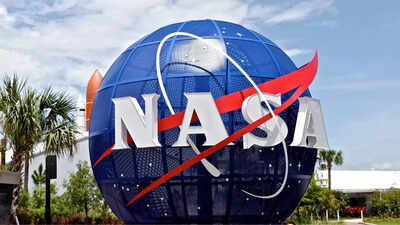Latest Education news – Board Exam Results, Admit Cards, Exam Paper Analysis and Question Papers | Times of India
The National Aeronautics and Space Administration (NASA)’s flotilla of satellites orbiting Earth and deep space is far more sophisticated than most people realise. These technological spectacles aren’t just scanning skies and taking mind-boggling pictures; they’re rewriting science and human understanding of space. These satellites are protecting our planet and unlocking cosmic mysteries far beyond. Here are 7 extraordinary capabilities that showcase the incredible ingenuity of modern space technology that students can’t afford to miss.
Laser highways in space replace traditional radio communication
Whilst most people assume satellites communicate through radio waves, NASA’s most advanced spacecraft are switching to laser technology for data transmission. These optical communication systems can beam information to Earth at speeds up to 100 times faster than conventional radio systems, whilst providing crystal-clear signal quality that doesn’t degrade over vast distances.The technology works by encoding data into pulses of laser light, creating what scientists call “optical highways” through space. This breakthrough allows satellites to transmit high-resolution images and complex scientific data in minutes rather than hours, revolutionising how quickly we can access information from the cosmos.
Earth’s gravity secrets revealed through microscopic measurements
NASA’s GRACE (Gravity Recovery and Climate Experiment) satellites possess an almost supernatural ability to detect the tiniest changes in Earth’s gravitational field. These twin spacecraft can measure gravitational variations as small as one part in a billion, effectively “weighing” different regions of our planet from space.This remarkable sensitivity allows scientists to track invisible phenomena with unprecedented precision. When ice sheets melt in Greenland or groundwater depletes in drought-stricken regions, these satellites detect the resulting gravitational changes before the effects become visible on the surface. The data has transformed our understanding of climate change, revealing that Earth loses approximately 150 billion tonnes of ice annually from its polar regions.
Geostationary guardians that never sleep
Some NASA satellites perform an incredible balancing act, appearing to hover motionlessly above specific points on Earth’s surface. These spacecraft achieve this seemingly impossible feat by matching Earth’s rotational speed in what’s called a geostationary orbit, positioned precisely 35,786 kilometres above the equator.This strategic positioning allows continuous monitoring of weather patterns, natural disasters, and atmospheric conditions over the same geographical region 24 hours a day. Weather forecasters rely on these stationary sentinels to track hurricane development, monitor volcanic eruptions, and provide early warnings for severe weather events that save countless lives.
Cosmic symphony: capturing the sounds of space
Space may be a vacuum where sound cannot travel, but NASA satellites have found ingenious ways to “hear” the cosmos. These spacecraft detect electromagnetic waves, solar wind interactions, and planetary magnetic field fluctuations, then convert these signals into audible frequencies that humans can hear.The results are both haunting and beautiful, from the ethereal whistles of Jupiter’s magnetosphere to the crackling static of solar storms. These cosmic sounds aren’t just curiosities; they provide crucial data about space weather, helping scientists predict potentially dangerous solar activity that could disrupt satellites, power grids, and communication systems on Earth.
Planet hunting through stellar shadows
NASA’s TESS (Transiting Exoplanet Survey Satellite) employs a brilliantly simple yet sophisticated technique to discover worlds beyond our solar system. The satellite monitors hundreds of thousands of stars simultaneously, watching for minute decreases in brightness that occur when planets pass in front of their host stars.These tiny dips in starlight, often less than 1% brightness reduction, reveal not only the existence of exoplanets but also their size, orbital period, and atmospheric composition. TESS has already discovered thousands of potentially habitable worlds, fundamentally changing our understanding of how common planetary systems are throughout the galaxy.
Earth’s disappearing atmosphere captured in real time
NASA satellites have made the startling discovery that Earth’s atmosphere is gradually leaking into space, with hydrogen and helium atoms escaping at rates measurable from orbit. This atmospheric escape occurs primarily from the upper atmosphere, where solar radiation provides enough energy for light gases to break free from Earth’s gravitational pull.Whilst this process occurs over geological timescales and poses no immediate threat, understanding atmospheric loss helps scientists predict long-term climate evolution and study how other planets may have lost their atmospheres. The research has particularly important implications for understanding Mars’s transformation from a potentially habitable world to the arid planet we see today.
Robotic mechanics in the void
Some of NASA’s most advanced satellites are equipped with sophisticated robotic arms and specialized instruments capable of performing delicate operations in the harsh environment of space. These mechanical marvels can capture defunct satellites, remove dangerous space debris, and even perform repairs on other spacecraft—all whilst travelling at thousands of kilometres per hour.The technology represents a crucial step towards sustainable space exploration, as the growing problem of space debris threatens future missions. These robotic systems can extend satellite lifespans, clear orbital pathways, and potentially salvage valuable equipment that would otherwise be lost forever.
Rewriting cosmic history
Perhaps most remarkably, satellites like the Hubble Space Telescope have fundamentally altered our understanding of the universe itself. By capturing images of galaxies billions of light-years away, essentially looking back in time, these instruments have helped determine that the universe is approximately 13.8 billion years old and expanding at an accelerating rate.This research earned multiple Nobel Prizes and revealed the existence of dark energy, a mysterious force comprising roughly 70% of the universe. Each deep-space image collected by these satellites represents a time machine, showing us how galaxies formed and evolved over cosmic history.
Source link
Anjali Mittal
#essential #facts #NASA #satellites #students #Times #India
